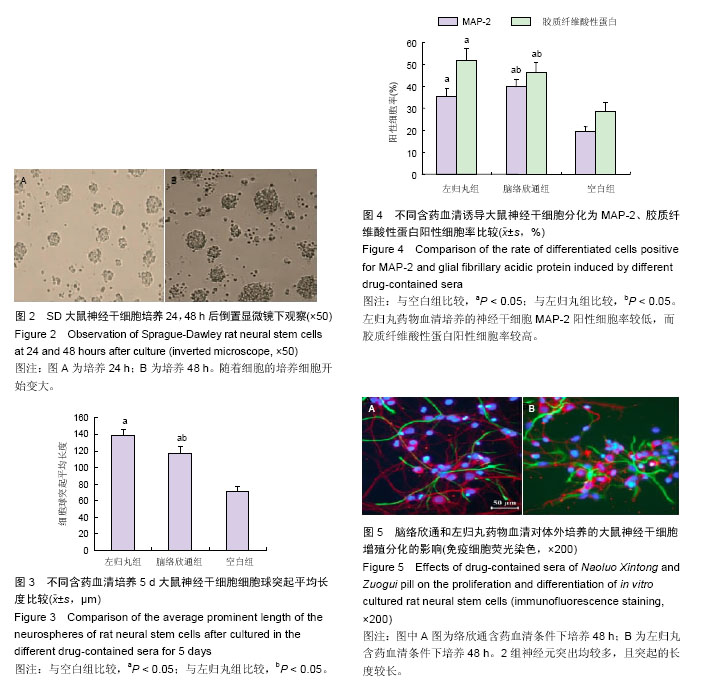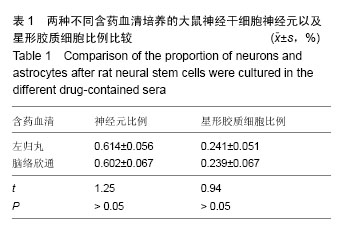| [1] 唐巍,王键,胡建鹏,等.大鼠胚胎脑源性神经干细胞的分离培养和鉴定[J].中国临床康复, 2006,10(11): 36-38.
[2] 高月彩,李蒙,李瑞玉,等.补肾中药在干细胞培养与移植中的干预作用[J].中国组织工程研究,2013,17(14):2609- 2616.
[3] 董立华,王勇,陆长青,等.黄芪诱导大鼠骨髓间充质干细胞分化为神经样细胞的研究[J].四川大学学报:医学版,2007, 38(3):417-420.
[4] Christie KJ,Emery B,Denham M,et al. Transcriptional regulation and specification of neural stem cells. Adv Exp Med Biol. 2013;786:129-155.
[5] 董燕湘,董晓先,何慧华,等.大鼠骨髓间质干细胞用中药绞股蓝诱导为神经细胞的研究[J].中华神经科杂志, 2003, 36(5):355-358.
[6] 高唱,王景周.左归丸对体外培养新生大鼠海马神经干细胞增殖分化的影响[J].中国医药学报,2004,19(11): 691-693.
[7] Si YC,Li Q,Xie CE,et al. Chinese herbs and their active ingredients for activating xue(blood) promote the proliferation and differentiation of neural stem cells and mesenchymal stem cells. Zhenghua Yixue. 2014;9(1): 13.
[8] 曾意荣,樊粤光,刘红,等.补肾活血中药对大鼠骨髓间充质干细胞体外增殖的影响[J].中国组织工程研究与临床康复,2008,12(8):1581-1585.
[9] Zhu S,Wildonger J,Barshow S,et al. The bHLH repressor deadpan regulates the self-renewal and specification of drosophila larval neural stem cells independently of notch. Plos One.2012;7(10): e46724.
[10] 程建,袁涛,马勇,等.中医药及骨髓间充质干细胞移植治疗激素性股骨头缺血性坏死的研究进展[J].中国中西医结合杂志,2012,32(7):1004-1007.
[11] 蓝海峰,袁振刚,张春阳,等.同胞异基因外周血干细胞移植治疗多发性骨髓瘤10例疗效观察[J].中华血液学杂志, 2012,33(3):191-194.
[12] Zhu DY,Lou YJ.Inducible effects of icariin, icaritin, and desmethylicaritin on directional differentiation of embryonic stem cells into cardiomyocytes in vitro.Acta Pharmacol Sin.2005,26(4):477-485.
[13] 冯珂,纪立金.健脾益智胶囊对大脑中动脉栓塞大鼠海马神经干细胞增殖及 Notch1、Jagged1表达的影响[J].中华中医药杂志,2013,(4):921-924.
[14] 胡建鹏,周会,王键,等. 益气活血方和补肾生髓方对局灶性脑缺血再灌注大鼠缺血半暗带Notch-1和Jagged1表达的影响[J].中国病理生理杂志,2010,26(3):483- 486.
[15] Wisniewska MB, Nagalski A, Dabrowski M, et al. Novel beta- catenin target genes identified in thalamic neurons encode modulators of neuronal excitability. Bmc Genomics.2012;13(1):1-12.
[16] 吕磊,胡建鹏,王键,等.益气活血方和补肾生髓方对脑缺血再灌注大鼠 Notch3和 Frizzled2 mRNA 及蛋白表达的影响[J].中国病理生理杂志,2013,29(7):1171- 1174.
[17] 姚璎珈,胡昱,李少恒,等. 蛇床子素可促进体外培养神经干细胞的增殖[J].中国组织工程研究,2014,18(32): 5184-5189.
[18] Chen BY,Wang X,Wang ZY,et al. Brain-derived neurotrophic factor stimulates proliferation and differentiation of neural stem cells, possibly by triggering the Wnt/β -catenin signaling pathway. J Neurosci Res. 2013;91(1):30-41.
[19] 宋祖荣,胡建鹏,徐伟,等.益气活血方和补肾生髓方对脑缺血再灌注大鼠海马 CA1 区 wnt5a、LRP5 蛋白表达的影响[J].辽宁中医药大学学报,2015,17(1):136-138.
[20] Li YB,Zhao XQ,Jiang YH,et al. Study on molecular target promoting human neural stem cells of ginsenoside Rg1 by gene chip.Zhongguo Zhong Yao Za Zhi. 2013;38(16):2701-2705.
[21] Collu GM,Hidalgo-Sastre A,Brennan K. Wnt Notch-signalling crosstalk in development and disease. Cell Mol Life Sci. 2014;71(18):3553-3567.
[22] Wu Y,Jing Z,Qin X,et al. Qingnaoyizhi decoction suppresses the formation of glial fibrillary acidic protein-positive cells in cultured neural stem cells by inhibiting the janus kinase 2/signal transducer and activator of transcription 3 signaling pathway. J Tradit Chin Med. 2015 Feb;35(1):69-76.
[23] 崔猛,冯世庆,范宁建,等.黄芩苷下调p-STAT3诱导神经干细胞向神经元分化[J].天津医药,2013,41(8):786-789.
[24] Yin Y,Huang P,Han Z,et al. Collagen nanofibers facilitated presynaptic maturation in differentiated neurons from spinal-cord-de-rived neural stem cells through MAPK/ERK1/2-Synapsin I signaling pathway. Biomacromolecules.2014;15(7):2449-2460.
[25] Zhao X,Li Y,Jiang Y,et al. Study on mechanism of ginsenoside Rg1-induced human neural stem cells differentiation by genechip. Zhongguo Zhong Yao Za Zhi. 2012 Feb;37(4):515-519.
[26] 韩辉,吴丽敏,方芳,等.人参川芎含药血清对氧糖剥夺/复氧培养神经干细胞 ERK 信号通路和增殖、活力的影响[J].中国中西医结合杂志,2013,33(4):510-515.
[27] ]Huang W,Zhao Y,Zhu X,et al.Fluoxetine upregulates phos-phorylated-akt and phosphorylated-erk1/2 proteins in neural stem cells: evidence for a crosstalk between akt and erk1/2 pathways. J Mol Neurosci. 2013;49(2):244-249.
[28] Cardozo AJ,Gómez DE,Argibay PF. Transcriptional characterization of Wnt and Notch signaling pathways in neuronal differentiation of human adipose tissue-derived stem cells. J Mol Neuros-ci.2011;44(3): 186-194.
[29] Li Y,Lau WM,So KF,et al.Caveolin-1 promotes astroglial differ-entiation of neural stem / progenitor cells through modulating Notch1/ NICD and Hes1 expressions. Biochem Biophys Res Commun. 2011;407(3): 517-524.
[30] Li Q,Lu J,Wang XY.Propofol and remifentanil at moderate and high concentrations affect proliferation and differentiation of neural stem/progenitor cells. Neural Regen Res. 2014;9 (22): 2002-2007.
[31] 刘柏炎,沈剑刚,蔡光先,等.补阳还五汤对局灶性脑缺血大鼠脑内caveolin1、2的影响[J].湖南中医药大学学报, 2008,28(1): 22-24,28.
[32] 储利胜,邵亮,孟丁瑜,等.补阳还五汤对大鼠局灶性脑缺血损伤的长期保护作用[J].中国临床康复,2006,10(11): 56-58.
[33] 刘柏炎,蔡光先,刘维,等.补阳还五汤对大鼠局灶性脑缺血后血管内皮生长因子及其受体Flk1的影响[J].中草药, 2007, 38(3): 394-397.
[34] 周荣峰,赵喜连,邓茜,等.芪棱汤对脑缺血后神经干细胞增殖分化作用的研究[J].中国中医急症,2009,18 (10): 1650-1651,1680.
[35] 李通,刘畅,寇雨霏,段伟,罗德欣.神经干细胞移植与脑梗死[J].中国组织工程研究,2013,17(40):7175-7180.
[36] 余剑,曾进胜,赵湛,等.表皮生长因子促进脑梗死后室管膜下区神经干细胞迁徙机制的初步研究[J].中风与神经疾病杂志,2007,24(1):4-7.
[37] 叶飞,席刚明,陈涛,等.胰岛素样生长因子1在脑梗死大鼠神经干细胞增殖、迁移和分化中的作用[J].中国组织工程研究与临床康复,2010,14(6):1125-1129.
[38] 唐强,白晶,王艳,等.头穴丛刺法调控大鼠脑梗死后内源性神经干细胞增殖迁移分化的实验研究[J].中国康复医学杂志,2009,24(8):676-679.
[39] Maciaczyk J,Singec I,Maciaczyk D,et al.Restricted spontaneous in vitro differentiation and region-specific migration of long-term expanded fetal human neural precursor cells after transplantation into the adult rat brain.Stem Cells Dev. 2009;18(7):1043-1058.
[40] Andres RH,Horie N,Slikker W,et al.Human neural stem cells enhance structural plasticity and axonal transport in the ischaemic brain.Brain. 2011,134(Pt 6):1777- 1789.
[41] 王亮,崔维韻,王新平,等.不同数量神经干细胞移植治疗实验性脑梗死[J].中国组织工程研究,2012,16(1):90-94. |
.jpg)


.jpg)
.jpg)
.jpg)